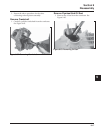
10.2
Section 10
Inspection and Reconditioning
The connecting rod journal can be ground one size
under. When grinding the crankshaft, grinding stone
deposits can get caught in the oil passages, which
could cause severe engine damage. Removing the
crankpin plug when the crankshaft is ground provides
easy access for removing any grinding deposits that
may collect in the oil passages.
Use the following procedure to remove and replace
the plug.
Procedure to Remove Crankshaft Plug:
1. Drill a 3/16" hole through the plug in the
crankshaft.
2. Thread a 3/4" or 1" long self-tapping screw with a
flat washer into the drilled hole. The flat washer
must be large enough to seat against the shoulder
of the plug bore. See Figure 10-2.
3. Tighten the self-tapping screw until it draws the
plug out of the crankshaft.
Procedure to Install New Plug:
1. Use a single cylinder camshaft pin Part No.
47 380 09-S as a driver and tap the plug into the
plug bore until it seats at the bottom of the bore.
Make sure the plug is tapped in evenly to prevent
leakage.
Inspect the crankshaft bearing surfaces for scoring,
grooving, etc. Measure the running clearance between
the crankshaft journals and their respective bearing
bores. Use an inside micrometer or telescoping gauge
to measure the inside diameter of both bearing bores
in the vertical and horizontal planes. Use an outside
micrometer to measure the outside diameter of the
crankshaft main bearing journals. Subtract the journal
diameters from their respective bore diameters to get
the running clearances. Check the results against the
specifications in Section 1. If the running clearances
are within specification, and there is no evidence of
scoring, grooving, etc., no further reconditioning is
necessary. If the bearing surfaces are worn or
damaged, the crankcase and/or oil pan will need to be
replaced.
Inspect the crankshaft keyways. If worn or chipped,
replacement of the crankshaft will be necessary.
Inspect the crankpin for score marks or metallic
pickup. Slight score marks can be cleaned with crocus
cloth soaked in oil. If wear limits, as stated in
“Specifications and Tolerances” are exceeded, it will
be necessary to either replace the crankshaft or regrind
the crankpin to 0.25 mm (0.010 in.) undersize. If
reground, a 0.25 mm (0.010 in.) undersize connecting
rod (big end) must then be used to achieve proper
running clearance. Measure the crankpin for size,
taper, and out-of-round.
NOTE: If the crankpin is reground, visually check to
insure that the fillet blends smoothly with the
crankpin surface. See Figure 10-1.
Figure 10-1. Crankpin Fillets.
Figure 10-2. Removing Crankpin Plug.
45°
High Point from
Fillet Intersections
This Fillet Area
Must Be Completely
Smooth
Minimum
The Fillet Must
Blend Smoothly
with the Bearing
Journal Surface
Flat Washer
Self-Tapping Screw
Plug
Crankshaft


















